四年级英语上册 Unit1 Meeting new people教案 沪教牛津版(三起)
- 格式:doc
- 大小:58.00 KB
- 文档页数:5
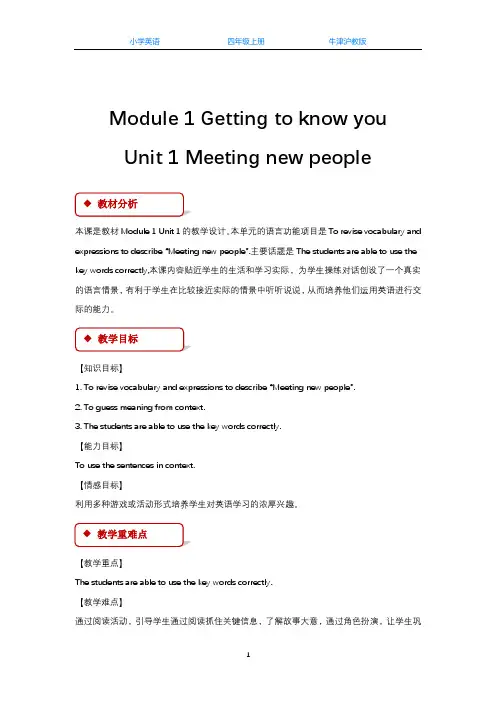
Module 1 Getting to know youUnit 1 Meeting new people本课是教材Module 1 Unit 1的教学设计。
本单元的语言功能项目是To revise vocabulary and expressions to describe “Meeting new people”.主要话题是The students are able to use the key words correctly,本课内容贴近学生的生活和学习实际,为学生操练对话创设了一个真实的语言情景,有利于学生在比较接近实际的情景中听听说说,从而培养他们运用英语进行交际的能力。
【知识目标】1. To revise vocabulary and expressions to describe “Meeting new people”.2. To guess meaning from context.3. The students are able to use the key words correctly.【能力目标】To use the sentences in context.【情感目标】利用多种游戏或活动形式培养学生对英语学习的浓厚兴趣。
【教学重点】The students are able to use the key words correctly.【教学难点】通过阅读活动,引导学生通过阅读抓住关键信息,了解故事大意,通过角色扮演,让学生巩固和运用本单元所学核心词汇和句型。
Tape recorder, Multimedia.Step 1. Warm up1. Listen and sayT: What do you know about “Meeting new people”?Look at the pictures on P2 and PPT. Talk about “Meeting new people”.To introduce them to the topic. And encourage them to talk about the topic.2. ListeningPlay the listening materials, stop when necessary. And then check the answers.To train the students’ ability of catching the information of the listening materials.Step 2. Presentation1. Look and learnLead them to read and explain the “Meeting new people”.e.g: This is your new classmate, his name is...2. Make and say(1) Learn the rules in P3.(2) Finish the exercise on P3 and group work to work out the usage method of the “Meeting new people”.(3) Walk around to exam the situation and check the answers for them.(4) List the method of for them.(5) To develop their interests and lead them to the conclusion.Step 3. Practice1. Say and actLet the students look PPT and act the scene.To make them get familiar with the details of the text and train their ability of saying and reading.2. Sing a song(1) Let the students look PPT and sing a song.(2) Let the students get the general idea of the text.3. Learn the letters(1) Learn the letters in P5.(2) List the letters for them.(3) To develop their interest and lead them to the conclusion.Step 4. Homework1. Dictation.2. Use the new words to make sentences on your own or check them in a dictionary.略。

Unit 1 Meeting new people开学第一课:The First PeriodThe Second PeriodThe Third PeriodThe Fourth PeriodUnit 5 Animals in dangerTeaching Aims(教学目标):1.能听、说、读、写本课的核心词汇:thousand, hundred, wild, way, die, learn, send, in danger, in the past, take care of2.能熟练掌握核心句型:In the past, there were many pandas.What can we do to help them?3.知道动物是人类的朋友,人类应该和动物建立良好的关系,要保护动物。
Teaching Importances and Difficulties (教学重难点):1.能在语境中正确运用本单元的核心词汇。
2.用There was/were …对某种东西的数量进行陈述。
3.了解字母u及字母组合ue、oo在单词中的发音规律,拼读简单的单词。
Teaching Tools(教学用具):录音机、自制课件、照片等Teaching Procedures(教学过程):StepⅠ. Warm up and revision(热身与复习)1. Sing a song.2. Play a game: Apple tree3. Count the numbers together.Step Ⅱ. Presentation and practice (自主探究)1. 生词关T: Please write the meanings on your paperthousand______ hundred______ wild________only________ about______ whale _________am/is_______(过去式) are______(过去式)2. T:Show the pictures and learn the new words: thousand, hundredSs:Read these words after teacher.3. Work in groups to read the new words. Recite the new words, then recite in groups。

Oxford English 4AModule 1 Getting to know youUnit 1 Meeting New People(Period 2)Teaching Design执教人:刘莉工作单位:合肥市蜀山小学2019年5月20日一、【Teaching content】Oxford English 4A Module 1 Unit 1 (period 2)二、【Analysis of Target Students】The 4th graders are my target students. They are very curious and interested in learning English. Some of my students are shy but most of them are very active in class. They are familiar with this topic: meeting new people, because they have learnt how to greet w ith friends when they were in Grade 3. But they don’t know how to introduce their friends’ names by using ‘His/Her name is…’.三、【Teaching Aims】Knowledge aimsby the end of class, students are able to:1) identify the new words: his, her, see you.2) know how to introduce other people by using:This is… His/her name is..Skill aimsby the end of class, students are able to:1) develop reading skills such as: skimming/scanning/guessing the meaning.2) develop communicative skills through pair work/ group work.Moral and Thinking aimsby the end of class, students are able to:1) know the importance of names2) develop creative thinking by imaging what may happen next after Picture 3.四、【Teaching Keys and Difficulties】Key points:1) Ss can introduce other s correctly by using ‘His/her name is…’2) Ss can know how to greet, introduce and say goodbye with each other.Difficult points:1) Ss can distinguish how to introduce boys’ names and girls’ names.2) Ss can introduce their families fluently.五、【Teaching Aids】1) Students’ book 4A. 2) A toy pig (Peppa) 3.Seewo software六、【Teaching Procedures】I. Pre-task preparationII. While-task proceduresIII. Post-task activitiesnobody? 置家庭阅读作业。
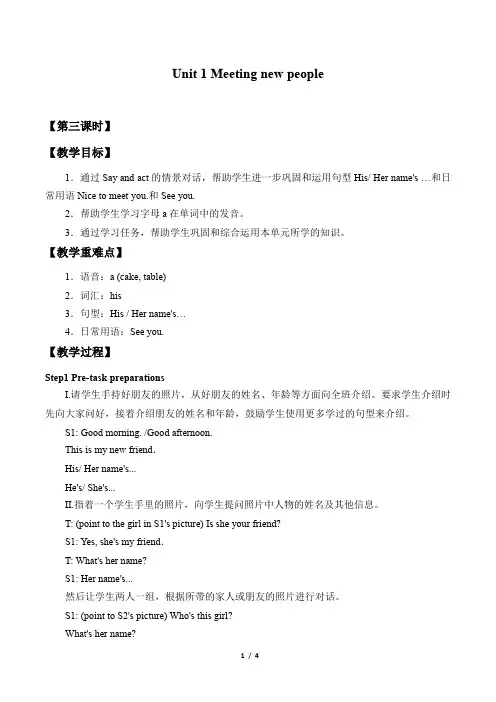
Unit 1 Meeting new people【第三课时】【教学目标】1.通过Say and act的情景对话,帮助学生进一步巩固和运用句型His/ Her name's …和日常用语Nice to meet you.和See you.2.帮助学生学习字母a在单词中的发音。
3.通过学习任务,帮助学生巩固和综合运用本单元所学的知识。
【教学重难点】1.语音:a (cake, table)2.词汇:his3.句型:His / Her name's…4.日常用语:See you.【教学过程】Step1 Pre-task preparationsI.请学生手持好朋友的照片,从好朋友的姓名、年龄等方面向全班介绍。
要求学生介绍时先向大家问好,接着介绍朋友的姓名和年龄,鼓励学生使用更多学过的句型来介绍。
S1: Good morning. /Good afternoon.This is my new friend.His/ Her name's...He's/ She's...II.指着一个学生手里的照片,向学生提问照片中人物的姓名及其他信息。
T: (point to the girl in S1's picture) Is she your friend?S1: Yes, she's my friend.T: What's her name?S1: Her name's...然后让学生两人一组,根据所带的家人或朋友的照片进行对话。
S1: (point to S2's picture) Who's this girl?What's her name?S2: She's my …Her name's …Step2 While-task proceduresI.播放Say and act的录音,在听录音之前,教师可以根据对话内容设计几个问题,如对话中的人物,人物的姓名,做什么事情等,让学生在听录音时重点关注这些信息。
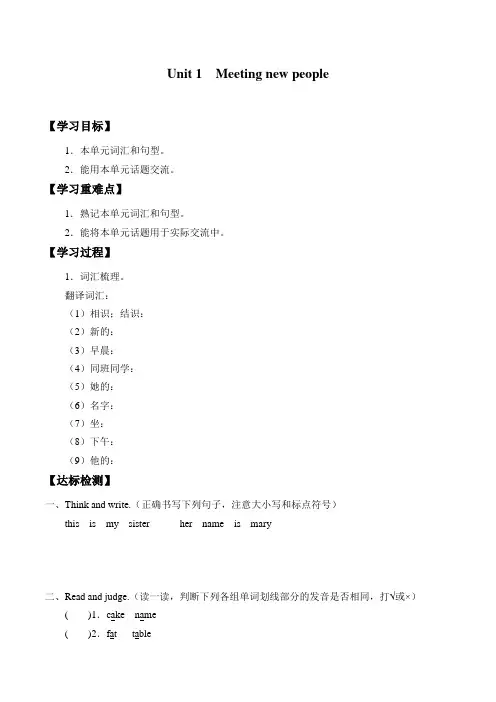
Unit 1 Meeting new people【学习目标】1.本单元词汇和句型。
2.能用本单元话题交流。
【学习重难点】1.熟记本单元词汇和句型。
2.能将本单元话题用于实际交流中。
【学习过程】1.词汇梳理。
翻译词汇:(1)相识;结识:_____________________(2)新的:___________________________(3)早晨:___________________________(4)同班同学:_______________________(5)她的:___________________________(6)名字:___________________________(7)坐:_____________________________(8)下午:___________________________(9)他的:___________________________【达标检测】一、Think and write.(正确书写下列句子,注意大小写和标点符号)this is my sister her name is mary_____________________________________________________________________________ _________________________________________________________________________________ _________________________________________________________________________________ 二、Read and judge.(读一读,判断下列各组单词划线部分的发音是否相同,打√或×)( )1.cake name( )2.fat table( )3.skate black( )4.taste make三、Think and choose.(选择填空)( )1.__________ father is a doctor(医生).A.He B.He’s C.His( )2.This is __________ basketball. It’s new.A.Martin B.Martin is C.Martin’s( ) 3.Danny and Ben are ___________.A.classmate B.classmates C.friend( )4.This is my sister. Her name is __________.A.Sally B.Danny C.Tommy( )5.Lucy has(有)a _________ schoolbag. She’s happ y(高兴的).A.new B.old C.small( ) 6.The lovely dog is only one __________ old.A./ B.year C.years( )7.This is Mr Fang. __________ a teacher.A.He’s B.is C.She’s( )8.Nice __________ meet you.A.to B.too C.two( )9.__________ you, Kitty.A.See B.Hi C.Bye( )10.You can ___________ here.A.sit B.sitting C.sits四、Think and write.(按要求改写下列句子)1.She is two years old.(对划线部分提问)_______________________________ she?2.I can fly a kite.(改为一般疑问句)_________ you _________ a kite?3.My sister is tall.(改为否定句,但意思不变)My sister _____________________.4.--Is this your doll, Alice?--Yes, it is.(根据对话填空)This doll is _____________________.5.H e’s my brother.(改为一般疑问句)__________he __________ brother?6.What’s your name?(根据实际情况回答)___________________________________.五、Read and judge.(阅读短文,判断句子正误,打√或×)Look at the picture. You can see two boys and a girl. They are my new friends. We are in the same(同一的;同样的)class.The boys are Peter and Steven. Peter is eleven years old.He’s tall and h e can play basketball(打篮球). He likes Yao Ming. His student number is fourteen. Steven is twelve years old.He’s fat. His student number is fifteen. He likes eating hamburgers(汉堡包). The girl is May. She is eleven. She’s thin and short. Her student number is twenty-two(22). She can’t draw, but she can sing and dance. After school, we often play together(一起).We are good friends.( )1.You can see three children in the picture.( )2.Peter and Steven are tall.( )3.Steven’s student numbe r is fourteen.( )4.Mar y isn’t tall.( )5.May can draw, sing and dance.六、口语部分1.Read aloud.(朗读下列词组和句子)(1)My new classmate.(2)in the morning.(3)Nice to meet you.(4)See you.(5)He’s ten years ol d.七、Look and say.(Alice正在做自我介绍。
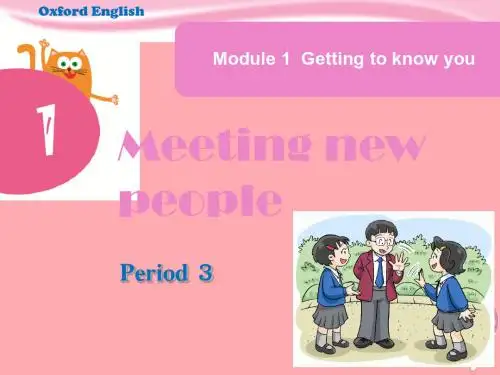

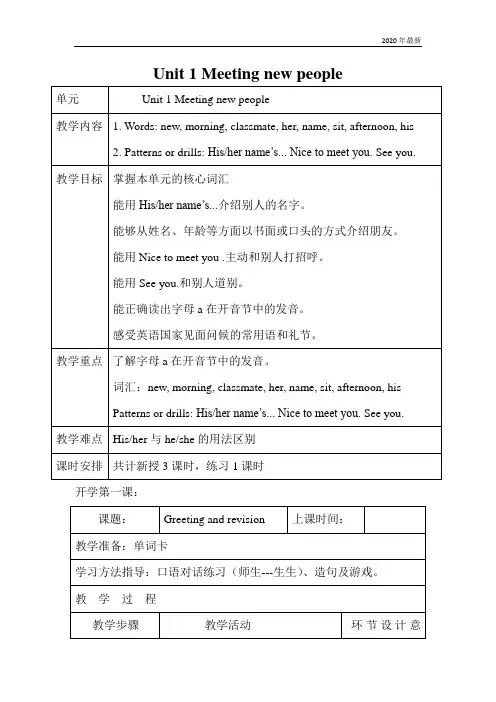

课题 / Topic
四年级英语上册(沪教2011课标版三年级起点)Module1 Getting to know you Unit1 Meeting new people
教学目标 / Teaching Aims:
1.知识与技能:(1)能够准确、熟练用句型This is….His/ Her name’s ….介绍
别人的名字, 用句型My name is … .介绍自己的名字;
用日常用语See you. 和别人道别;
用日常用语Nice to meet you (too). 与新朋友互相打招呼。
(2)能够在生活实际情境中遇到新朋友时做恰当地交谈。
2. 过程与方法:(1)能够理解、表达和表演课文内容;
(2)能够初步在恰当的情境中,综合运用本单元所学的句型和日常
用语。
3. 情感态度与价值观:启发学生在生活中遇到新朋友时,自信、礼貌、勇敢地与其
交流,生活中应善交朋友。
重点 / Key points: 句型This is… .His/ Her name’s….My name is… .日常用语See you. Nice to meet you (too).的准确运用。
难点 / Difficult points: 1.在日常具体生活情境中应用本单元句型和日常
用语。
2.应用学生的知识储备进行文本的再构。
教具 / Teaching Aids: 多媒体课件。
教学过程设计/ Teaching Procedure
Blackboard Design / 板书设计。
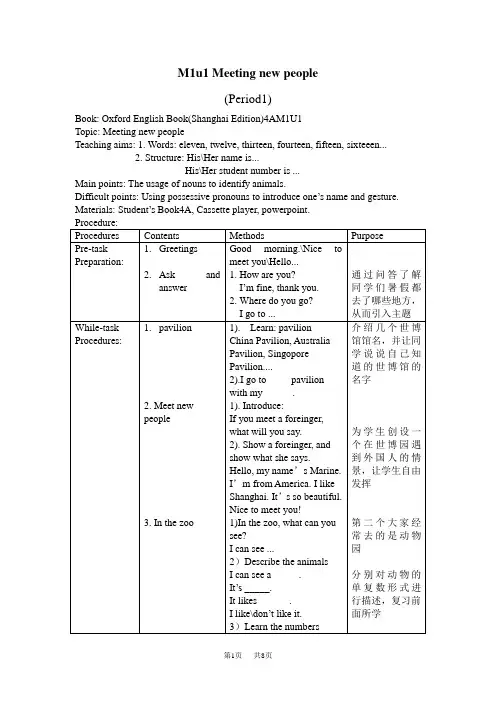
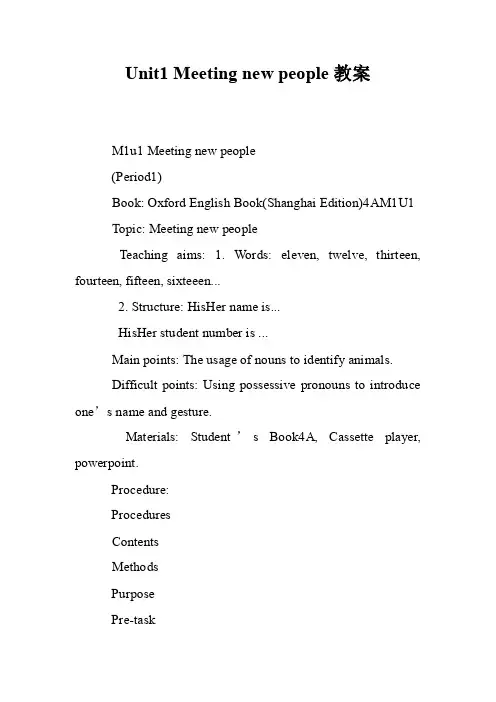
Unit1 Meeting new people教案M1u1 Meeting new people(Period1)Book: Oxford English Book(Shanghai Edition)4AM1U1Topic: Meeting new peopleTeaching aims: 1. W ords: eleven, twelve, thirteen, fourteen, fifteen, sixteeen...2. Structure: HisHer name is...HisHer student number is ...Main points: The usage of nouns to identify animals.Difficult points: Using possessive pronouns to introduce one’s name and gesture.Materials: Student’s Book4A, Cassette player, powerpoint.Procedure:ProceduresContentsMethodsPurposePre-taskPreparation:1. Greetings2. Ask and answerGood morning.Nice to meet youHello...1. How are you?I’m fine, thank you.2. Where do you go?I go to ...通过问答了解同学们暑假都去了哪些地方,从而引入主题While-taskProcedures:1. pavilion2. Meet new people3. In the zoo3.New classmates1). Learn: pavilionChina Pavilion, Australia Pavilion, Singopore Pavilion....2).I go to ____ pavilion with my______.1). Introduce:If you meet a foreinger, what will you say.2). Show a foreinger, and show what she says. Hello, my name’s Marine.I’m from America. I likeShanghai. It’s so beautiful.Nice to meet you!1)In the zoo, what can you see?I can see ...2)Describe the animalsI can see a _____.It’s _____.It likes ______.I likedon’t like it.3)Learn the numbersEleve, twelve, thirteen, fourteen, sixteen... 1).Ask:How many new classmates are there?There are..2). Do a surveyAsk questions:What’s your name?How old are you?What can you do?3)Student numberRead the new phrases.My student number is...4) HisHer student number is...介绍几个世博馆馆名,并让同学说说自己知道的世博馆的名字为学生创设一个在世博园遇到外国人的情景,让学生自由发挥第二个大家经常去的是动物园分别对动物的单复数形式进行描述,复习前面所学学习数字11到100新学期开始,班里来了几位新同学做了小调查,了解一下新同学的情况说说自己的学号,然后了解新同学的学号,并且说一说Post-taskactivity:Say and。
Module 1 Getting to know youUnit 1 Meeting new people教材分析本课是教材Module 1 Unit 1的教学设计。
本单元的语言功能项目是To revise vocabulary and expressions to describe “Meeting new people”.主要话题是The students are able to use the key words correctly,本课内容贴近学生的生活和学习实际,为学生操练对话创设了一个真实的语言情景,有利于学生在比较接近实际的情景中听听说说,从而培养他们运用英语进行交际的能力。
教学目标【知识目标】1. To revise vocabulary and expressions to describe “Meeting new people”.2. To guess meaning from context.3. The students are able to use the key words correctly.【能力目标】To use the sentences in context.【情感目标】利用多种游戏或活动形式培养学生对英语学习的浓厚兴趣。
教学重难点【教学重点】The students are able to use the key words correctly.【教学难点】通过阅读活动,引导学生通过阅读抓住关键信息,了解故事大意,通过角色扮演,让学生巩固和运用本单元所学核心词汇和句型。
课前准备Tape recorder, Multimedia.教学过程Step 1. Warm up1. Listen and sayT: What do you know about “Meeting new people”?Look at the pictures on P2 and PPT. Talkabout “Meeting new people”.To introduce them to the topic. And encourage them to talk about the topic.2. ListeningPlay the listening materials, stop when necessary. And then check the answers.To train the students’ ability of catching the information of the listening materials.Step 2. Presentation1. Look and learnLead them to read and explain the “Meeting new people”.e.g: This is your new classmate, his name is...2. Make and say(1) Learn the rules in P3.(2) Finish the exercise on P3 and group work to work out the usage method of the “Meeting new people”.(3) Walk around to exam the situation and check the answers for them.(4) List the method of for them.(5) To develop their interests and lead them to the conclusion.Step 3. Practice1. Say and actLet the students look PPT and act the scene.To make them get familiar with the details of the text and train their ability of saying and reading.2. Sing a song(1) Let the students look PPT and sing a song.(2) Let the students get the general idea of the text.3. Learn the letters(1) Learn the letters in P5.(2) List the letters for them.(3) To develop their interest and lead them to the conclusion.Step 4. Homework1. Dictation.2. Use the new words to make sentences on your own or check them in a dictionary.。
Unit 1 Meeting new people 一、基本知识点(一)词汇:meet [miːt]new [njuː]morning ['mɔːnɪŋ]classmate ['klɑːsmeɪt]her [hɜː]name [neɪm]sit [sɪt]afternoon [ɑːftə'nuːn]his [hɪz](二)短语:Good morningNice to meet youThank youGood afternoonGoodbyeMake cakesOn the plateOn the table(三)句型:1. Her name’s Jill.她的名字是Jill.2.Good morning,boys ans girls.早上好,男孩女孩们.3.This is your new classmate.这是你的新同学。
4.The cakes are on the plates.蛋糕在盘子里。
5.Jane likes cakes.Jane 喜欢蛋糕。
(四)重难点、易错点:1. 介绍他人句型This is .....2.介绍自己的名字My name’s....3.形容词性物主代词的用法His name’s....Her name’s....3.介绍年龄He is ten.4.询问对方What about you?5. 写作:学会如何描述一个朋友(名字、关系、年龄、所在学校)This is ____________________________名字He/She is ___________________________关系He/She is ___________________________年龄He/She is ___________________________所在学校二、典型例题1. This ________ your new classmate.A. isB. amC. are【解析】答案:A 根据句意:“这是你的新同学”。
英语四年级上册Unit1MeetingnewPeople-教案-沪教牛津版
(深圳用)
四年级英语上册Module1 Getting to know you Unit1 Meeting new people
教学目标 / Teaching Aims:
1.知识与技能:(1)能够准确、熟练用句型This is….His/ Her name’s ….介绍
别人的名字, 用句型My name is … .介绍自己的名字;
用日常用语See you. 和别人道别;
用日常用语Nice to meet you (too). 与新朋友互相打招呼。
(2)能够在生活实际情境中遇到新朋友时做恰当地交谈。
2. 过程与方法:(1)能够理解、表达和表演课文内容;
(2)能够初步在恰当的情境中,综合运用本单元所学的句型和日常
用语。
3. 情感态度与价值观:启发学生在生活中遇到新朋友时,自信、礼貌、勇敢地与其
交流,生活中应善交朋友。
重点 / Key points: 句型This is….His/ Her name’s….My name is… .日常用语See you. Nice to meet you (too).的准确运用。
难点 / Difficult points: 1.在日常具体生活情境中应用本单元句型和日常用语。
2.应用学生的知识储备进行文本的再构。
教具 / Teaching Aids: 多媒体课件。
教学过程设计/ Teaching Procedure。
Module 1 Unit 1 教案2一、教学重点词汇:new,classmate,her,name,sit句型:Her name’s Jill.二、教学栏目Listen and say,Listen and enjoy,Make and say三、教学目标1. 通过Listen and say的情景对话,帮助学生学习核心句型Her name’s Jill.2. 通过角色扮演,帮助学生初步运用核心句型。
3. 通过Make and Say活动,让学生进一步稳固和运用核心句His/Her name’s …。
四、教学步骤Pre-task preparations1. 接龙游戏。
用Listen and enjoy的儿歌向学生问好,学生答复老师的问候以后,接着用问题What about you? 随意向任意学生提问。
T: Good morning. Good morning.My name’s …What about you? (point toS1)S1: Good morning. Good morningMy name’s …What about you? (point to S2)S2: Good morning. Good morning.My name’s …What about you? (point toS3)S3: …2. 准备一个小木偶,以小木偶的语气用第—人称作自我介绍,引出生词new。
在学生听懂的根底上,鼓励学生主动站起来和小木偶打招呼,并作自我介绍。
T: Hello. My name’s Peggy. I'm new here. Nice to meet you.S1: Good morning, Peggy. My name’s … Nice to meet you too.T: Good morning, my new friend.将木偶交给答复的学生,请他(她)扮演小木偶,去和同学对话。
四年级上册 Unit 1 Meeting new people教案牛津版www.5ykj.com 四年级上册Unit1meetingnewpeople教案牛津版m1U1meetingnewpeople学情分析学生已经接触了基本的问候打招呼句型,这节课只是复习巩固教学目标与考点分析掌握本课有关数字的新单词,并会默写数字one-sixteen;学会如何用Thisis...句型向别人介绍自己的新同学、自己的好朋友;会用can的句型来介绍自己或别人能做什么事。
教学重点难点Thisis...句型的运用;情态动词can的用法教学方法情景教学法,讲练结合教学法warm-upFreetalk:跟学生打招呼,问候,相互熟悉。
Teacher:Hello!I’m...S1:Hi!I’m...S2:Hello!I’m...whoareyou?S3:I’m...复习数字onetwothreefourfivesixseveneightnineten 导入本课数字学习。
PresentationandPractice)单词:eleventwelvethirteenfourteenfifteensixteen拓展单词:classmateonetwothreefourfivesixseveneightnineten 2)基本句型:Thisis...这是、、、Seeyou.再见。
-Nicetoseeyou.很高兴见到你。
-Nicetoseeyoutoo.也很高兴见到你。
基于课本进行讲解。
Part1:LookandsayGoodmorning,Peter.Goodmorning,kitty.Thisismysister.HernameisSally.She’stwelve.Andthisismybrother.HisnameisPaul.He’sonlysix.Hi,Sally.Hi,Paul.mynameiskitty.I’mPeter’sclassmate.Hi,kitty.wearegoingtothepark.Goodbye,kitty.Part2:AskandanswerShowaphotoofyourfriend.Thentalkabouthim/her.Thisismyfriend.Hisname’sDanny.He’snine.Hecanrideabicycle.Thisismyfriend.Hername’sTracy.She’sthirteen.Shecanskip.S:Thisismy...His/Hername’s...He’s/She’s...He/Shecan...3)语法:.形容词性物主代词my,her,his,your在英语中有物主代词,它可以分成名词性的和形容词性的。
Meeting new people
Part 1: Look and say
Good morning, Peter.
Good morning, Kitty.
This is my sister. Her name is Sally. She’s twelve.
And this is my brother. His name is Paul. He’s only six.
Hi, Sally. Hi, Paul. My name is Kitty. I’m Peter’s classmate. Hi, Kitty.
We are going to the park. Goodbye, Kitty.
Part 2: Ask and answer
Show a photo of your friend. Then talk about him/ her.
This is my friend. His name’s Danny. He’s nine. He can ride a bicycle. This is my friend. Her name’s Tracy. She’s thirteen. She can skip. S: This is my ... His /Her name’s ...
He’s/ She’s ... (age)
He / She can ...
3)语法:
1. 形容词性物主代词 my, her, his, your
在英语中有物主代词,它可以分成名词性的和形容词性的。
形容词性物主代词相当于形容
词,置于名词前,在句子中用于修饰名词,做定语,后面必须跟一个名词。
例如:This is my brother. His name is Tom. 这是我的哥哥。
他叫汤姆。
形容词性物主代词有人称和数的变化,
单数形式:my(我的),your(你的),his /her/its(他的、她的、它的)。
复数形式:our(我们的),your(你们的),their(他们的)。
练习:
1. This is my book. are over there.
A. Your
B. Yours
C. You
D. Mine
2. Whose pen is it? It’s .
A. her
B. hers
C. she
D. his
3. __ bag is new and __ is new, too.
A. Our, he
B. Ours, his
C. My, his
D. My, her
4. This room is ours, and that one is __.
A. they
B. them
C. theirs
D. their
5. Whose pencils are there? They’re __.
A. my
B. me
C. mine
D. our
6. Is the new watch __? Yes, it’s __.
A. you, me
B. yours, mine
C. your, my
D. your, mine
7. Whose shoes are these? They are __.
A. me
B. mine
C. my
D. I
8. She is a student , __ name is Han Mei.
A. its
B. her
C. hers
D. his
9. It’s a dog. I don’t know __ name.
A. its’
B. its
C. it
D. it’s
10. This ruler isn’t mine. I think it is __.
A. he
B. him
C. his
D. her
11.__ schoolbag is beautiful. But __ is more beautiful.
A. Jims, my
B. Jim’s, mine
C. Jim’s, me
D. Jims’, I
12. __ am a boy and __ is a girl.
A. My, she
B. I, her
C. I, she
D. Mine, she
13.I like __ new dress.
A. She
B. her
C. hers
D. his
14.I often help __ mother do __ housework(家务活)。
A. me, she
B. mine, her
C. my, her
D. I, hers
15.Is that __hat? No, it’s not __. It’s __.
A. your, my, Toms
B. you, mine, Tom’s
C. yours, mine, Tom
D. your, mine, Tom’s
2. 情态动词Can
can后的动词必须是原形,否定形式can’t
例如:肯定句:He can swim very fast.
否定句:He can’t sing.
疑问句:Can he climb a tree?
回答: Yes, he can. / No, he can’t.
练习:
将下面各组词组成句子
1.________________________(an,aeroplane,hear,Lucy,can )
2. ____________________________ (not,he ,dance,can )
3.____________________________? (you,can ,see,what )
4.____________________________(can ,see ,not ,we ,you)
5._____________________________. (I ,can ,help ,you )
6._____________________________? (I,can ,do,what)
7._____________________________? (you ,can ,hear me)
8._____________________________? (you ,can ,dance)
3. 名词所有格:
所有格的构成方法:
(1) 一般情况(包括单数名词和不带词尾s的复数名词)加 -’s:
children’s books 儿童图书
today’s paper 今天的报纸
(2) 带词尾s的复数名词只加省字撇(‘):
girls’ school 女子学校
the S miths’ car 史密斯家的小汽车
注:带词尾s的单数名词,通常仍加’s:
the boss’s plan 老板的计划
the hostess’s worry 女主人的担心
(3) 带词尾s带词尾的人名,可加’s 或只加省字撇(‘):
Dickens’ novels 狄更斯的小说
Charles’s job 查理斯的工作
注:不带词尾-s却以咝音结尾者,一律加’s却以咝音结尾者,Marx’s works 马克思的著作
George’s room 乔治的房间
Closure(10 minus)
1)带领学生复习总结今天所学单词和句型,一般是提问的方式。
2)放学前一个一个学生检查今天单词和基本句型的朗读。